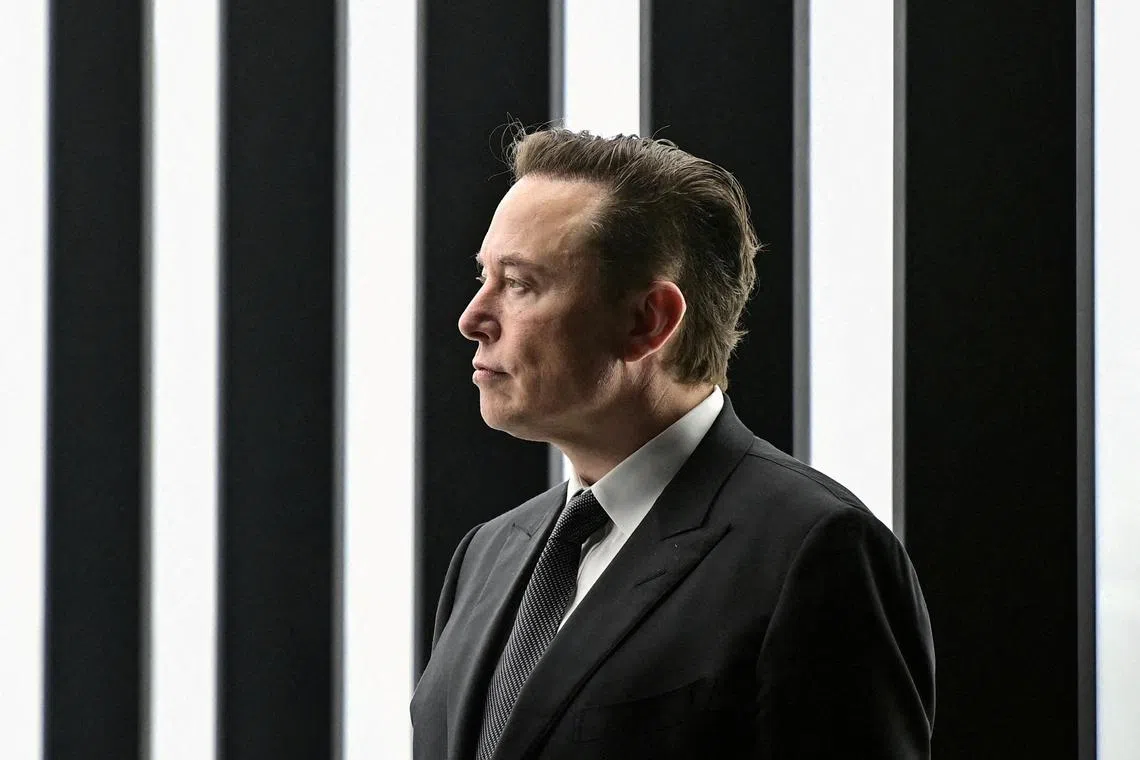Commentary: Elon Musk has a new master plan for Tesla, again
Sign up now: Get ST's newsletters delivered to your inbox

The future of Tesla, whose chief executive is Mr Elon Musk, seems to be built on self-driving cars and humanoid robots.
PHOTO: REUTERS
Liam Denning
Follow topic:
The lifespan of Tesla’s “master plans”, strategic missives from chief executive Elon Musk, has declined dramatically.
The first held for a decade. The third, just superseded by Master Plan Part IV, did not even make its third birthday.
An optimist, of which Tesla’s shareholder ranks have no shortage, might take that as a sign that the future is arriving faster and plans must shift accordingly.
In reality, it is a sign that Tesla has been unable to will its future into being quickly enough and must therefore redefine it again.
The most compelling evidence for this is that Master Plan Part IV is not a plan.
Generously, and borrowing a favourite phrase of one of Mr Musk’s more prominent frenemies, it might be described as a concept of a plan.
Far from laying out a blueprint for tomorrow, it offers nostalgia for yesteryear and the sort of vague futurism you might plausibly conjure up on artificial-intelligence chatbot Grok with a spare half-hour. (It was actually published on X, Mr Musk’s social media platform, rather than Tesla’s website.)
The first master plan read more like one, outlining a standard bootstrapping strategy of building an expensive electric vehicle (EV), then using the money from that to make a cheaper one to grow the market and so on.
Tesla mostly delivered on that, although its claim in the latest version that it leveraged profits from early models to build new ones rather overlooks the lack of profits and reliance instead on accommodating capital markets through the 2010s.
Back when “part deux” was released in 2016, however, I noted that it read less like a plan and more like a manifesto.
The overarching ambition of fostering sustainable energy was still there, but the steps to get there were more diffuse. They now encompassed solar roof-plus-storage home energy systems, electric trucks and buses, and self-driving cars.
By 2023, when the third plan was unveiled, Mr Musk recapitulated the sustainable energy themes again in something like an extended TED Talk, only this time with a mysterious, forthcoming low-cost EV playing the starring role.
As the ambition broadened, the achievements narrowed. The solar roof promise was made at a time when Mr Musk was drumming up support for Tesla’s dubious acquisition of another, and struggling, venture he was involved in, SolarCity. Tesla no longer even reports solar installations.
The electric semi-truck, meanwhile, is like the giant squid of transportation: You know it is there, but it is rarely seen in the wild. The smaller Cybertruck has been a dud, and the electric bus has appeared as a concept.
Tesla’s low-cost EV, meanwhile, was ditched about a year after it was teased. After that, Tesla went all-in on robotaxis.
Yet, almost 1½ years on, and years since Mr Musk first pledged autonomous vehicles roaming the land, the company operates a limited, invite-only service in part of Austin and a glorified Uber service in the Bay Area in the US.
Tesla also just lost a potentially landmark liability case involving its Autopilot driver-assistance system.
This is the essential context for the latest master plan.
While the sequels have delivered Hollywood-esque diminishing returns in terms of innovation, they have helped to keep faith in Tesla’s most important product, its stock.
Despite having fallen 18 per cent so far in 2025, its multiple of forecast earnings for the year recently cracked 200 times for the first time.
Tesla’s core EV business has been shrinking since 2023, the same year it was talking of selling 20 million units by 2030, or more than 10 times what it is forecast to sell in 2025.
Hence, the latest plan reiterates Tesla’s as-yet-unproven autonomy chops, but really goes all in on humanoid robots, complete with images of its Optimus droid serving drinks and watering a plant.
The aim now is nothing less than the transformation of the concept of labour and human society itself. The tagline is “sustainable abundance”, twinned with statements like “growth is infinite” and that all “worthwhile stories… begin with a first step”.
I think people can agree that a future with robots taking over more manual tasks would indeed be transformational – welcome in some respects and perhaps problematic in others – and is likely over some timeframe.
But bromides about that, as opposed to some specific breakthrough or timeline or literally anything with a number or deadline attached to it, do not constitute a recognisable plan.
Not so long ago, one of the more bullish analysts covering Tesla was ascribing hundreds of billions of dollars of value to the company’s in-house artificial intelligence chip effort, dubbed Dojo. That is now being disbanded.
Yet now, on the back of the flimsiest master plan yet, Mr Musk claims Optimus will account for about “80 per cent of Tesla’s value”.
The approximation there lends a comedic touch.
More importantly, while bulls may swoon at the implication of Tesla morphing into a robotic pioneer, they would be overlooking all the other things it was supposed to become, and at an ever quickening pace, but somehow did not. BLOOMBERG

